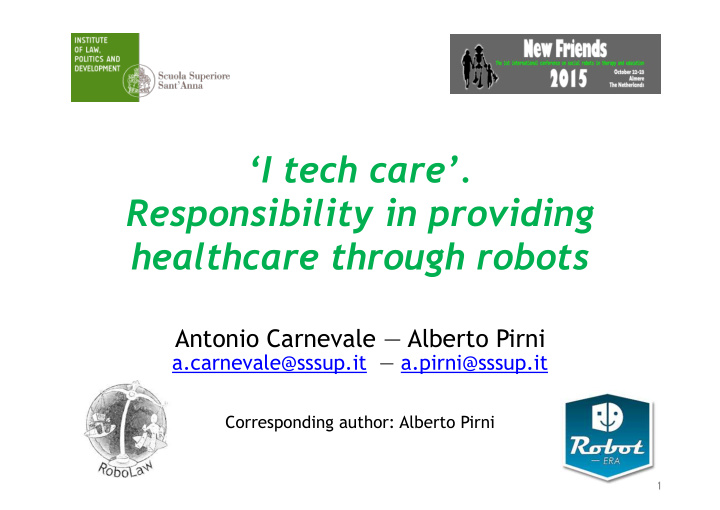



‘I tech care’. Responsibility in providing healthcare through robots Antonio Carnevale — Alberto Pirni a.carnevale@sssup.it — a.pirni@sssup.it Corresponding author: Alberto Pirni 1
Personal Care Robots (PCRs), Ethics and Sustainability TODAY … • Robots come in many forms • Companies and laboratories continue to implement prototypes What does it mean the “ethical • Much research being done, resulting in prototypes sustainability” of a PCR? • Few assistive robots in use today ➢ The Governance of technology • High cost and uncertain benefits are major barriers to their widespread adoption ➢ The difficulty of “drawing the … FOR THE FUTURE line” (medical / service [or care] robots; substitutive / assisting robots) ➢ The new framework offered by the ISO Strategy” 2010-2020) 13482 • An ageing society of European countries (“European Disability Need for healthcare systems to shorten hospital stay ➢ From “ROBOT-LAW” and“ROBOT-ERA” • Projects: the variability of scenarios (indoor/outdoor/urban) and the respective • Home-based health care critical issues • Deep transformation of social agencies that guaranteed healthcare in the past and at nowadays ➢ The Governance of society ➢ Beyond the regulatory level (safety … SOME OF THE MAIN RISKS and liability): challenging the structure • Affecting the dignity of elderly and disabled people of our societies (“they are among us” effect) • Isolation / dependence ➢ Social contexts of interaction at stake: • “Techno-fix” (extra “technology” nulla salus - Rosner 2014) Seidensticker 2006) ➢ care, • “Hype of technology” (considering only the positive side ➢ work, ➢ welfare ➢ human rights The “Second Level” Challenge: ➢ Combining both levels of governance 2
How to Approach an Ethical Analysis of Personal Care Robots 1) The stakeholders a) Opportunity: the point of view of industries, operators,end users, etc. b) Risk: Selection Attitude/ positive bias towards technology, The point of view of the end users c) The diacronic / epistemic gap 2) The scientific debate a) The difficulty of a distinction between medical and assistive robotics “healthcare robots” (Van der Loos & Reinkensmeyer, 2008; Datteri & Tamburrini, 2009). Consequences: • Overlapping the ethics of robot-producers with the ethical concerns of the society within which the robots are introduced • Using a too large and generic ethical and legal vocabulary for evaluation of new prototypes and devices b) “Vulnerability” as anthropological condition (Lisetti et al., 2004; Sparrow & Sparrow, 2006; Turkle et al., 2006; Coeckelbergh, 2010). c) New Scientific Challenges • The challenge against standards • The cultural variable • Reshaping the concept of “social acceptability” 3
The “ethical sustainability test”: Values at stake Safety a) Hard (physical) Risks b) Soft (economic, psychological) Risks c) Specific Challenges for PRCs General Overview Systemic Overview 1. The kind of contact between robot and people is not always clear “Assistive Robotics” ➢ Socially Interactive Robotics” ➢ 2. Safety requirements and protective measures in the domestic environment 3. Safety related to maintainance and control requirements Liability Autonomy & Independence Privacy Social connectedness New technologies and equality of access New technologies, ethics and scientific research 4 Thank you for your attention! http://www.cdg-lab.dirpolis.sssup.it/en/staff/academic/antonio-carnevale/ http://www.cdg-lab.dirpolis.sssup.it/en/staff/academic/alberto-pirni/
Recommend
More recommend